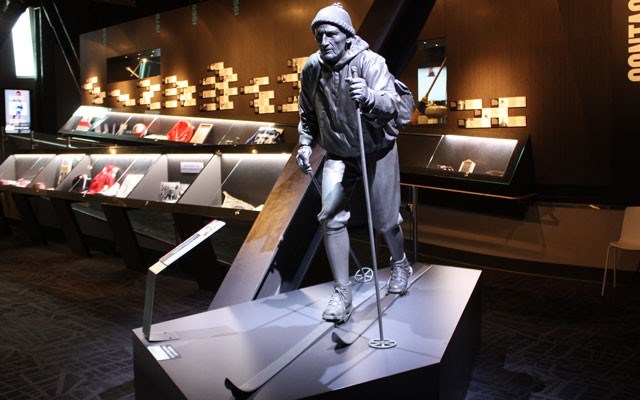Up until a few years ago, virtually every person in Canada who has ever donned a pair of cross-country skis knew who Herman Smith "Jackrabbit" Johannsen was. When he died peacefully in his sleep in Tönsberg, Norway, on Jan. 5, 1987, at age 111, he had not only been recognized briefly as the world's oldest living man, but was one of Canada's most famous citizens, a living North American legend for over half a century. As daughter Alice wrote in a 1993 biography of her father (The Legendary Jackrabbit Johannsen, McGill-Queens University Press) the lives of "literally thousands of skiers and outdoor people... had been touched, one way or another... people on both continents, both young and old, who could rightfully claim a personal connection with him, and who could proudly say that they had actually 'followed in his tracks.'"
In reality, Jackrabbit was for many years the world's greatest ski personality of any stripe — ever. With the story of his life rapidly and quite naturally fading from the snow sports radar with time, it's worth reintroducing him to a new generation. Perhaps more so in a year when so many cross-country lovers in Whistler have had their hearts repeatedly broken by the pernicious weather of a changing climate.
Born in Norway in 1875, Johannsen emigrated to the U.S. as a young engineer at the turn of the century. Bouncing between Cuba, Canada, New York and other U.S. states for some two decades, it wasn't until 1928 that he finally moved permanently to Canada with his wife and children and settled in Montréal. His love of skiing — sated during weekend trips outside the city — eventually drew him to the Laurentians to live, where he cut hundreds of miles of tracks through the forests, including the famous Maple Leaf Trail (part of this route brushes Mont Tremblant, crossing a secondary summit called Johanssen Peak). An unrepentant outdoorist, Jackrabbit skied well past his 100th birthday. After his wife of 56 years died at the age of 81 in 1963, he lived alone in Piedmont, Québec, until he was 109, before moving back to Norway. His indomitable spirit eventually fled this earth in the country of his birth after a lengthy bout with flu and pneumonia.
Lesser-known than the details of his life is how one man's pioneering of skiing on this continent — first in the Adirondacks' Lake Placid area and then later in the Laurentians — inspired so many thousands (including myself) to take up ski-touring, how he became a virtual synonym and symbol of cross-country skiing on both sides of the border, and had a national teaching system (Cross-Country Canada's Jackrabbit Program) and ski museum named for him here in the Great White North. Perhaps the best way to gain insight into his enormous influence is through a few simple vignettes drawn from his biography.
First off, Jackrabbit loved taking people out to ski, but wasn't hung up on the nitty-gritty of instruction. He tended to opine that practical experience paid off better than lessons. "When you rattle down a lumber road, and suddenly meet head-on with a team of horses and a sleighload of logs," he'd famously said, "that's when you learn to ski in a hurry!"
Furthermore, although his guided tours were legendary, he never deigned to charge for them. Instead, he espoused a remarkable, genuine and endearing ski philanthropy that was the very antithesis of the emerging commercial alpine-instructor model. "Why should I take money for something I love to do?" he'd remarked. "This is a joy I can share with others, without it costing me a cent. There is a great deal I can't afford to do these days, but a love of skiing is something I can give, and that makes me really happy."
In Montréal during the Great Depression, forced to sell everything and move his family several times, Jackrabbit heroically insisted on making weekend trips north to the Laurentians on the ski trains that ran from the city. He firmly believed that it was not a luxury, but "... an absolute necessity both for our health and our peace of mind... After all, getting out into nature is really a kind of health insurance, and it's a lot cheaper than going to the doctor!" This rang true to the many who suddenly found skiing a welcome escape from the grind of existence in those days.
Early on, in the course of his engineering and business pursuits, Jackrabbit spent a good deal of time in the bush with miners, lumbermen and First Nations folk. Whenever a winter trek to some bush site was called for, the various crews usually set out on snowshoes while Jackrabbit always departed on skis. Invariably, especially when conditions were difficult, he demonstrated the superiority of skis for winter travel, often arriving at a destination hours ahead of the rest. This impressed everyone and resulted in many converts to his cause. Self-power was also a favourite topic: although he helped engineer and promote some of the first ski lifts in Canada, he had little interest in using them himself. "I've spent enough of my life feeling cold skiing downhill. Darned if I want to freeze going uphill, too!"
Perhaps most importantly, wherever he went in a lifetime of travelling the globe, Jackrabbit sought out fellow skiers. He was perhaps the first to recognize the unspoken bond and fast camaraderie that characterizes this special fraternity — the great wide unifying world of skiing. And it was his tireless promotion of the sport that helped make those bonds stronger for all of us, regardless of discipline.
Leslie Anthony is a Whistler-based author, editor, biologist and bon vivant who has never met a mountain he didn't like.




